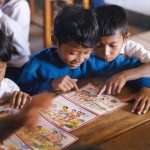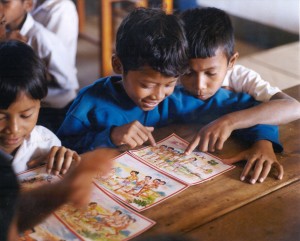Though Cambodia has achieved recent success in its fight against the spread of HIV, the disease continues to pose a very real threat, and the youth of Cambodia may be among the country’s most vulnerable. Building on past collaborative efforts, World Education and Cambodia’s Ministry of Education, Youth and Sport (MoEYS) partnered together in the Life Skills for HIV and AIDS Education Program (LSHE) from 2005-2007. The initiative reached youth in and out-of-school in eight provinces across the country with a life-skills approach to HIV prevention that also includes peer education initiatives for secondary students and out-of-school youth and, on a limited basis, primary students. The LSHE project was able to improve the awareness, attitudes and behaviors of youth in its target regions in regards to HIV and AIDS and also improved the capacity of MoEYS to design and carry out future interventions related to HIV.
The growing HIV epidemic puts the lives and futures of Cambodian youth at great risk. With more than 50% of Cambodians under the age of 20, it remains of vital importance to educate youth about HIV and AIDS to help them avoid infection. The goal of the Scaling-Up Pre-Service Teacher Training for HIV and AIDS Education Project was to reduce the numbers of HIV and AIDS infections in Cambodia through a comprehensive education program aimed at primary school students.
To help change behaviors and attitudes of youth (ages 15 to 24) related to HIV and AIDS, World Education implemented interventions targeting in-school and out-of-school youth in Takeo and Pursat provinces. The HIV prevention education strategies combined an emphasis on life skills, nonformal education curriculum development and training.
Promoting Healthy Youth entailed creating health clubs for in-school youth as a means of getting students interested in the topics of HIV and AIDS through membership and participation in the clubs. Club members engaged in HIV education and outreach activities, community mobilization, and IEC development and dissemination.
The goal of HIV and AIDS Prevention for In-School and Out-of-School Youth was to change behaviors and attitudes of youth (ages 15 to 24) related to HIV and AIDS, thereby making them less vulnerable to HIV and AIDS infection. IEC and Life Skills for Out-of-School Youth worked with adolescent boys and young men, adolescent girls and young women, and married couples. World Education employed a two-pronged strategy for behavior change among out-of-school youth. Individualized life skills classes for each of the three groups combined issues of HIV awareness and human sexuality with a range of additional topics highly relevant to the individual sub-populations. Peer education was also carried out among all three youth sub-populations, to provide opportunities for counseling and information dissemination to take place in informal settings. Local communities were heavily involved in project implementation.
Food security and a lack of awareness of basic nutrition continue to be problems in many parts of Cambodia, and the resulting poor health and malnutrition adversely affect the development and school attendance of children. The goal of the Green Health Project was to achieve sustainable improvements in the quality of life of children and their families in poor rural areas through better diets and more effective participation by children in education.
The Green Health Project was implemented in three districts in Prey Veng Province. Six communities saw nutrition and vegetable integrated pest management and local life skills programs and community demonstration gardens in year 1. Year 2 focused on scaling up project activities in 15 targeted communities. Funding was provided by the Food Security Initiatives Fund, a joint Canadian International Development Agency/Royal Government of Cambodia fund managed by the Canadian Cooperation Office.

To help protect young people from the dangers posed by landmines and UXO, the Ministry of Education, Youth, and Sports and World Education developed and implemented the Mine Risk Education Project for Children. Funded primarily through UNICEF, the two and a half year long project trained teachers and school administrators living in the most affected districts to plan and carry out activity-ba sed mine risk education programs for school children, and organize community-based mine awareness activities, with a particular focus on out-of-school youth.
sed mine risk education programs for school children, and organize community-based mine awareness activities, with a particular focus on out-of-school youth.
